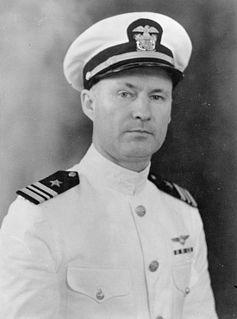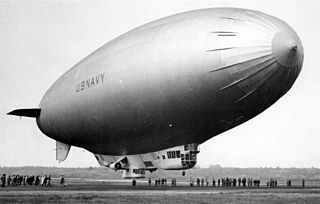
An airship or dirigible balloon is a type of aerostat or lighter-than-air aircraft that can navigate through the air under its own power. Aerostats gain their lift from a lifting gas that is less dense than the surrounding air.

The ZMC-2 was the only successfully operated metal-skinned airship ever built. Constructed at Naval Air Station Grosse Ile by The Aircraft Development Corporation of Detroit, the ZMC-2 was operated by the U.S. Navy at Lakehurst, New Jersey from 1929 until its scrapping in 1941. While at Lakehurst it completed 752 flights, and logged 2265 hours of flight time.

A hangar is a building or structure designed to hold aircraft or spacecraft. Hangars are built of metal, wood, or concrete. The word hangar comes from Middle French hanghart, of Germanic origin, from Frankish *haimgard, from *haim and gard ("yard"). gard comes from the Old Norse garðr.

Hell Divers is a 1932 American pre-Code black-and-white film from Metro-Goldwyn-Mayer starring Wallace Beery and Clark Gable as a pair of competing chief petty officers in early naval aviation. The film, made with the cooperation of the United States Navy, features considerable footage of flight operations aboard the Navy's second aircraft carrier, the USS Saratoga, including dramatic shots of takeoffs and landings filmed from the Curtiss F8C-4 Helldiver dive bombers after which the movie was named.

Charles Emery Rosendahl was a highly decorated vice admiral in the United States Navy, and an advocate of lighter-than-air flight.

Lakehurst Maxfield Field, formerly known as Naval Air Engineering Station Lakehurst, is the naval component of Joint Base McGuire–Dix–Lakehurst, a United States Air Force-managed joint base headquartered approximately 25 miles (40 km) east-southeast of Trenton in Manchester Township and Jackson Township in Ocean County, New Jersey, United States. It is primarily the home to Naval Air Warfare Center Aircraft Division Lakehurst, although the airfield supports several other flying and non-flying units as well. Its name is an amalgamation of its location and the last name of Commander Louis H. Maxfield, who lost his life when the R-38/USN ZR-2 airship crashed during flight on 24 August 1921 near Hull, England.

The K-class blimp was a class of blimps built by the Goodyear Aircraft Company of Akron, Ohio for the United States Navy. These blimps were powered by two Pratt & Whitney Wasp nine-cylinder radial air-cooled engines, each mounted on twin-strut outriggers, one per side of the control car that hung under the envelope. Before and during World War II, 134 K-class blimps were built and configured for patrol and anti-submarine warfare operations, and were extensively used in the Navy’s anti-submarine efforts in the Atlantic and Pacific Ocean areas.

The L-class blimps were training airships operated by the United States Navy during World War II. In the mid-1930s, the Goodyear Aircraft Company built a family of small non-rigid airships that the company used for advertising the Goodyear name. In 1937 the United States Navy awarded a contract for two different airships, K-class blimp designated K-2 and a smaller blimp based upon Goodyear's smaller commercial model airship used for advertising and passenger carrying. The smaller blimp was designated by the Navy as L-1. It was delivered in April 1938 and operated from the Navy's lighter-than-air facility at Lakehurst, New Jersey. In the meantime, the Navy ordered two more L-Class blimps, the L-2 and L-3, on September 25, 1940. These were delivered in 1941. L-2 was lost in a nighttime mid-air collision with the G-1 on June 8, 1942.

The Goodyear Aircraft Company of Akron, Ohio built the M-class blimp for the US Navy as the follow-on to the K-class anti-submarine warfare blimp used during World War II. It was a significantly larger airship, 50% larger than its predecessor. Four airships, designated M-1 through M-4, were delivered in early 1944. Operations of K-ships in tropical regions had shown a need for a blimp with greater volume to offset the loss of lift due to high ambient temperatures.

The N-Class, or as popularly known, the "Nan ship", was a line of non-rigid airships built by the Goodyear Aircraft Company of Akron, Ohio for the US Navy. This line of airships was developed through many versions and assigned various designators as the airship designation system changed in the post World War II era. These versions included airships configured for both anti-submarine warfare and airborne early warning (AEW) missions.

Joint Base McGuire–Dix–Lakehurst is a United States military facility located 18 miles (29 km) southeast of Trenton, New Jersey. The base is the only tri-service base in the United States Department of Defense and includes units from all six armed forces branches.

The American Blimp MZ-3A is a blimp owned by the United States Navy from 2006 to 2017. It is a modified American Blimp Corporation A-170 series commercial blimp and given the USN type/model/series (T/M/S) designation MZ-3A and Bureau Number (BuNo) 167811. After delivery to the Navy, the airship began operations as an advanced flying laboratory used to evaluate affordable sensor payloads, the development of new lighter-than-air (LTA) technologies and general flight support for other related research and development/science and technology (R&D/S&T) projects. It was the last airship to be operated by the U. S. military.

Naval Air Station South Weymouth was an operational United States Navy airfield from 1942 to 1997 in South Weymouth, Massachusetts. It was first established as a regular Navy blimp base during World War II. During the postwar era the base became part of the Naval Air Reserve Training Command, hosting a variety of Navy and Marine Corps reserve aircraft squadrons and other types of reserve units. Like most BRAC sites, environmental contamination was detected in 1986, and since 1993 numerous remedies and long term monitoring of ground water are in place. Since 2005, over 600 acres have been transferred to the affected towns for reuse, and in 2011 the Navy signed a $25 million contract to transfer its remaining land.

Naval Air Station Glynco, Georgia, was an operational naval air station from 1942 to 1974 with an FAA airfield identifier of NEA and an ICAO identifier of KNEA.

Hangar No. 1 is an airship hangar located at Naval Air Engineering Station Lakehurst in Manchester Township, in Ocean County, New Jersey, United States. It was the intended destination of the rigid airship LZ 129 Hindenburg prior to the Hindenburg disaster on May 6, 1937, when it burned while landing. Built in 1921, it is one of the oldest surviving structures associated with that period's development of lighter-than-air flight. It was designated a National Historic Landmark in 1968.
The Weeksville Dirigible Hangar is an airship manufacturing, storage and test facility originally built by the United States Navy in 1941 for servicing airships conducting anti-submarine patrols of the US coast and harbors. It is located on the former Naval Air Station Weeksville in Elizabeth City, North Carolina, approximately 2 miles southeast of the present day Coast Guard Air Station Elizabeth City.
In the nation's quest to provide security along its lengthy coastlines, air reconnaissance was put forth by the futuristic Rear Admiral William A. Moffett. Through his efforts, two Naval Air Stations were commissioned in the early 1930s to port the Naval Airships (dirigibles) which he believed capable of meeting this challenge.
The United States Navy proposed to the U.S. Congress the development of a lighter-than-air station program for anti-submarine patrolling of the coast and harbors. This program proposed, in addition to the expansion at Naval Air Station and Lakehurst, the construction of new stations. The original contract was for steel hangars, 960 ft (290 m) long, 328 ft (100 m) wide and 190 ft (58 m) high, helium storage and service, barracks for 228 men, a power plant, landing mat, and a mobile mooring mast.
There are three historic airship hangars at Moffett Field, in Mountain View in the southern San Francisco Bay Area, California. Hangar One is based on a structure of steel girders, while Hangars Two and Three are of wood. They are among the world's largest freestanding structures.















